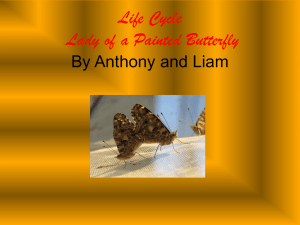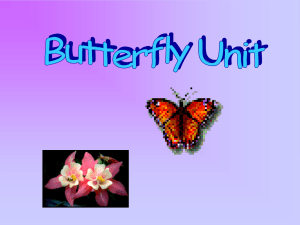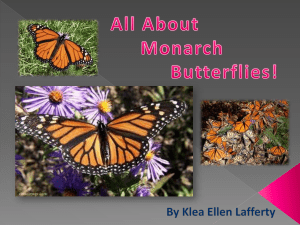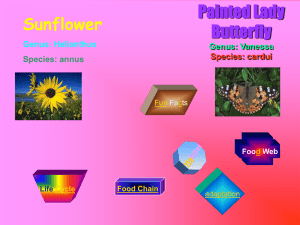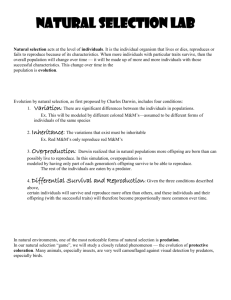Butterflies in Your Backyard
advertisement
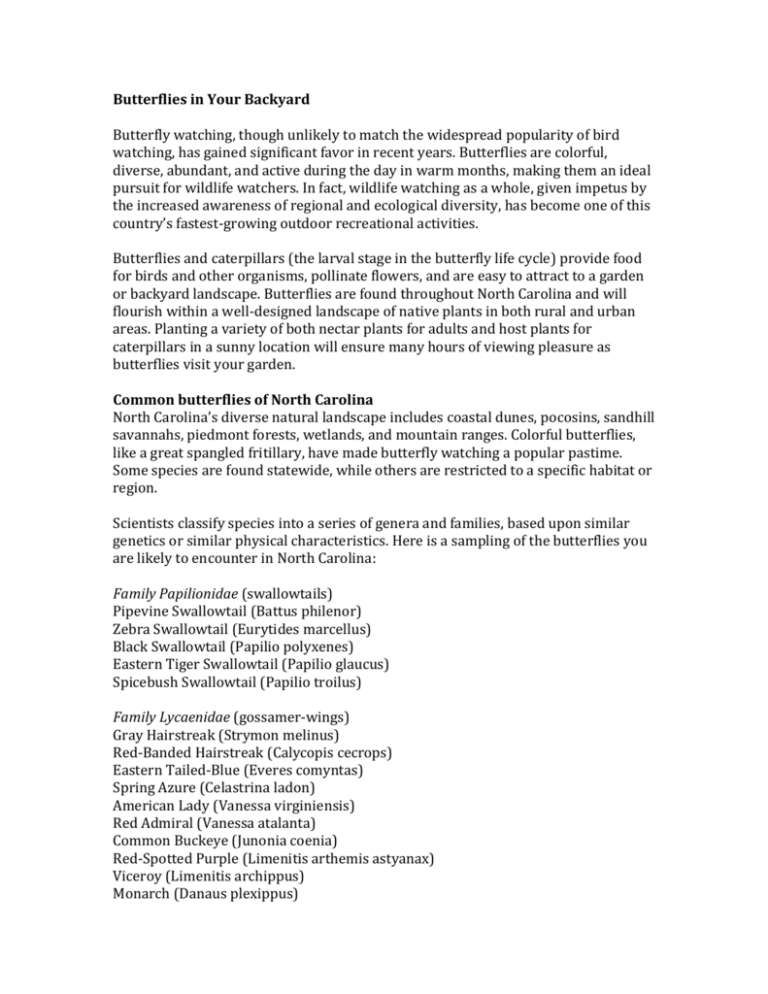
Butterflies in Your Backyard Butterfly watching, though unlikely to match the widespread popularity of bird watching, has gained significant favor in recent years. Butterflies are colorful, diverse, abundant, and active during the day in warm months, making them an ideal pursuit for wildlife watchers. In fact, wildlife watching as a whole, given impetus by the increased awareness of regional and ecological diversity, has become one of this country’s fastest-growing outdoor recreational activities. Butterflies and caterpillars (the larval stage in the butterfly life cycle) provide food for birds and other organisms, pollinate flowers, and are easy to attract to a garden or backyard landscape. Butterflies are found throughout North Carolina and will flourish within a well-designed landscape of native plants in both rural and urban areas. Planting a variety of both nectar plants for adults and host plants for caterpillars in a sunny location will ensure many hours of viewing pleasure as butterflies visit your garden. Common butterflies of North Carolina North Carolina’s diverse natural landscape includes coastal dunes, pocosins, sandhill savannahs, piedmont forests, wetlands, and mountain ranges. Colorful butterflies, like a great spangled fritillary, have made butterfly watching a popular pastime. Some species are found statewide, while others are restricted to a specific habitat or region. Scientists classify species into a series of genera and families, based upon similar genetics or similar physical characteristics. Here is a sampling of the butterflies you are likely to encounter in North Carolina: Family Papilionidae (swallowtails) Pipevine Swallowtail (Battus philenor) Zebra Swallowtail (Eurytides marcellus) Black Swallowtail (Papilio polyxenes) Eastern Tiger Swallowtail (Papilio glaucus) Spicebush Swallowtail (Papilio troilus) Family Lycaenidae (gossamer-wings) Gray Hairstreak (Strymon melinus) Red-Banded Hairstreak (Calycopis cecrops) Eastern Tailed-Blue (Everes comyntas) Spring Azure (Celastrina ladon) American Lady (Vanessa virginiensis) Red Admiral (Vanessa atalanta) Common Buckeye (Junonia coenia) Red-Spotted Purple (Limenitis arthemis astyanax) Viceroy (Limenitis archippus) Monarch (Danaus plexippus) Family Hesperiidae (skippers) Silver-Spotted Skipper (Epargyreus clarus) Long-Tailed Skipper (Urbanus proteus) Southern Cloudywing (Thorybes bathyllus) Juvenal’s Duskywing (Erynnis juvenalis) Horace’s Duskywing (Erynnis horatius) Least Skipper (Ancyloxypha numitor) Fiery Skipper (Hylephila phyleus) Sachem (Atalopedes campestris) Clouded Skipper (Lerema accius) Family Nymphalidae (brushfoot butterflies) American Snout (Libytheana carinenta) Variegated Fritillary (Euptoieta claudia) Great Spangled Fritillary (Speyeria cybele) Pearl Crescent (Phyciodes tharos) Question Mark (Polygonia interrogationis) Eastern Comma (Polygonia comma) Mourning Cloak (Nymphalis antiopa) Life cycle Butterflies and moths are unique because they change from a caterpillar to a winged adult through a process called metamorphosis. A typical butterfly’s life begins as an egg, generally laid on the leaf of a host plant. A host plant is a plant that caterpillars like to eat. Eggs soon hatch into caterpillars, which act as eating machines to devour leaves of the host plant. Caterpillars often have very specific food requirements that restrict them to a particular plant. After a few weeks, the caterpillar molts into a mummy like stage with a hard protective casing, called a pupa or chrysalis. While in the chrysalis, the caterpillar is transformed into an adult. At the end of about 2 weeks, the adult emerges from the chrysalis, spreads and dries its wings. Following successful mating, the female begins her search for a host plant on which to deposit her eggs, and the life cycle begins again. Males’ and females’ colors may vary slightly, and females generally are larger than males. But size cannot be used to distinguish between the sexes because individuals of any single species may vary in how big they are, depending on the amount and quality of food they ate as caterpillars. Most butterflies lay their eggs on a specific type of plant, called their host plant, which their caterpillars later feed on. Exceptions include Harvester caterpillars, which eat woolly aphids, and a few other caterpillars that eat rotting leaves rather than living plant foliage. Depending upon the species, adult butterflies can live from 1 week to 9 months. Physiology and behavior Butterflies and moths are insects in the order Lepidoptera, meaning “scaly-winged.” A person who studies these creatures is called a “lepidopterist.” Moths may have whip-like, fernlike, or fuzzy antennae with no knobs at their ends. Butterfly antennae are smooth, thin, and whip-like with a terminal knob. Butterfly wings are covered with thousands of tiny overlapping scales arranged like shingles on a roof. Colors such as blue, green, violet, gold, and silver on butterfly wings are not caused by pigment, but rather by light reflecting off the wing scales. Butterflies and caterpillars breathe through “spiracles,” which are tiny openings along the sides of their bodies. Butterflies can smell with their antennae. Butterflies have compound eyes that allow them to see the colors red, green, and yellow. Their eyes do not rotate to follow a predator’s movement; rather, they detect movement as the object moves from one facet of the eye to the next. Butterflies (and other insects) have an exoskeleton, or structural support on the outside of their bodies, to protect them and keep in fluids so they don’t dry out. Butterflies use special nerve cells called chemoreceptors on the pads of their feet to “taste” food and identify leaves of their caterpillar’s host plant before they lay their eggs. In some butterfly species, females and males look different. Male butterflies often congregate at “puddling” areas, which include mud puddles, moist soil along stream banks, and animal feces. There they ingest salts important in sperm production. Different species of butterflies have characteristic behaviors. For example, some perch on leaves, guarding an area and chasing away intruders. Others appear to constantly patrol certain areas and rarely perch. Butterflies bask in the sun to warm their bodies before they fly. Their wings act as solar collectors. Butterflies are most active during the warmest parts of the day, but in temperatures of over 100° F, they may become overheated and seek shade. Passionflower and many other native plants provide an ideal habitat for butterflies in your backyard. A cluster of orange coneflower plants with taller purple coneflowers growing in the background allows butterflies easy access to abundant nectar without excessive exposure to predators. Eggs, caterpillars, and adult butterflies have many predators. To avoid them, females lay eggs in concealed locations on the host plant, and caterpillars often look inconspicuous. To scare away predators, some caterpillars have large eye-spots that resemble a snake’s head. Other caterpillars have protective spines, release obnoxious scents, or just plain taste bad. Most species of butterflies survive the winter by hibernating as caterpillars, pupae, or adults. A few spend the winter as eggs. Fewer still migrate to warmer climates. Those species that spend the winter as adults tuck themselves behind loose bark or in trees. Adult butterflies may feed on nectar from flowers, but some prefer rotten fruit or tree sap. They suck the liquid food through a straw-like “tongue.” Using native plants to attract butterflies Native plants generally are defined as those that occurred in North America before European settlement. Exotic plants are those that are not native. Plants native to your area grow well because they are specifically adapted to the climate, soils, temperature, and precipitation. Native plants are those to which regional butterflies have adapted, and therefore, they are ideal for butterfly gardening and for larger restoration projects. Creating a butterfly habitat Diversity An effective butterfly habitat provides everything a butterfly needs to complete its life cycle. Provide a good diversity of host plants to attract a variety of butterflies and their caterpillars. Caterpillars are voracious but picky eaters, and many feed only on a particular species of plant. Choose a variety of nectar plants that will provide food throughout the growing seasons, as different species of butterfly are active from early spring through late fall. Choose flowers with blooms of different sizes and depths. Smaller butterflies, such as hairstreaks and skippers, have shorter proboscises and are unable to reach the nectar in larger blooms. Larger butterflies, such as swallowtails, favor larger blooms. Consider the moisture and light requirements of plants before introducing them to your butterfly habitat. Choose only the plants most appropriate for your area. Visit butterfly gardens at local nature centers or botanical gardens and observe which flowering plants attract butterflies. Do not get discouraged if a particular plant does not attract butterflies as anticipated. Experiment and find out which plants work in your butterfly habitat. Peelings and cores of fruit (peeled, overly ripe bananas work well) can be discarded in partially shaded nooks in the garden where they will attract butterflies that eat rotting fruit. Some native host plants for North Carolina butterflies Scientific Name Common Name Butterfly Larvae Trees Betula alleghaniensis Yellow Birch Mourning Cloak, Dreamy Duskywing Betula lenta Sweet Birch Betula nigra River Birch Carya glabra Pignut Hickory Banded Hairstreak Carya tomentosa Mockernut Hickory Celtis laevigata* Hackberry American Snout, Mourning Cloak, Question Celtis tenuifolia Sugarberry Mark, Hackberry Emperor, Tawny Emperor Chamaecyparis thyoides Atlantic White Cedar Hessel’s Hairstreak Fraxinus americana White Ash Eastern Tiger Swallowtail Ilex opaca American Holly Henry’s Elfin Juniperus virginiana Eastern Redcedar Juniper Hairstreak Liriodendron tulipifera* Yellow Poplar Eastern Tiger Swallowtail Persea borbonia Redbay Palamedes Swallowtail Pinus echinata Shortleaf Pine Eastern Pine Elfin Pinus taeda Loblolly Pine Populus deltoides Cottonwood Viceroy, Red-Spotted Purple Prunus americana Wild Plum Coral Hairstreak, Eastern Tiger Swallowtail, Prunus angustifolia Chickasaw Plum Red-Spotted Purple, Spring Azure, Viceroy Prunus serotina* Black Cherry Quercus spp. Oaks Banded Hairstreak, Edward’s Hairstreak, Gray Hairstreak, White-M Hairstreak, Horace’s Duskywing, Juvenal’s Duskywing Robinia pseudoacacia* Black Locust Clouded Sulphur**, Zarucco Duskywing, Silver-Spotted Skipper Salix caroliniana Carolina Willow Eastern Tiger Swallowtail, Mourning Cloak, Salix nigra* Black Willow Eastern Comma**, Red-Spotted Purple, Viceroy Sassafras albidum* Sassafras Spicebush Swallowtail Ulmus alata Winged Elm Painted Lady**, Eastern Comma, Mourning Cloak, Ulmus americana* American Elm Question Mark, Red-Spotted Purple** Small Trees Alnus serrulata Alder Harvester (carnivorous larvae eat woolly aphids commonly found on alder) Amelanchier arborea Serviceberry Red-Spotted Purple, Viceroy** Asimina triloba Pawpaw Zebra Swallowtail Carpinus caroliniana Ironwood Eastern Tiger Swallowtail, Red-Spotted Purple Cercis canadensis Redbud Henry’s Elfin Cornus florida Flowering Dogwood Spring Azure Crataegus spp. Hawthorn Gray Hairstreak, Red-Spotted Purple**, Viceroy** Myrica cerifera Wax Myrtle Red-Banded Hairstreak Rhus copallina Winged Sumac Red-Banded Hairstreak Rhus glabra Smooth Sumac Symplocos tinctoria Sweetleaf King’s Hairstreak Shrubs Asimina parviflora Dwarf Pawpaw Zebra Swallowtail Ceanothus americanus New Jersey Tea Mottled Duskywing Gaylussacia dumosa Dwarf Huckleberry Henry’s Elfin Gaylussacia frondosa Blue Huckleberry Ilex glabra Inkberry Henry’s Elfin Lindera benzoin Spicebush Palamedes Swallowtail, Spicebush Swallowtail Phoradendron serotinum Mistletoe Great Purple Hairstreak Vaccinium arboreum Sparkleberry Brown Elfin Vaccinium corymbosum Highbush Blueberry Vaccinium stamineum Deerberry Vines Aristolochia macrophylla Dutchman’s Pipe Pipevine Swallowtail Passiflora incarnata Passionflower Gulf Fritillary, Variegated Fritillary, Zebra Swallowtail Herbs and Wildflowers Agalinus spp. Gerardia Common Buckeye Antennaria plantaginifolia Plantain-Leaved Pussytoes American Lady Antennaria solitaria Solitary Pussytoes Aristolochia serpentaria Virginia Snakeroot Pipevine Swallowtail Aruncus dioicus Goat’s Beard Dusky Azure Asclepias incarnata Swamp Milkweed Monarch Asclepias tuberosa Butterfly Weed Asclepias variegata White Milkweed Aster carolinianus Climbing Aster Pearl Crescent Aster novae-angliae New England Aster Baptisia tinctoria Wild Indigo Wild Indigo Duskywing Boehmeria cylindrica False Nettle Eastern Comma, Question Mark, Red Admiral Chamaecrista fasciculata Partridge Pea Cloudless Sulphur, Little Yellow, Sleepy Orange Chelone glabra White Turtlehead Baltimore Checkerspot, Common Buckeye** Cimicifuga racemosa Black Cohosh Appalachian Azure Cirsium horridulum Yellow Thistle Little Metalmark, Painted Lady Desmodium spp. Beggarlice Silver-Spotted Skipper, Hoary Edge, Northern Cloudywing, Southern Cloudywing, Gray Hairstreak, Eastern Tailed-Blue Eupatorium fistulosum Joe-Pye-Weed Pearl Crescent Gnaphalium obtusifolium Rabbit Tobacco American Lady Helianthus atrorubens Sunflower Silvery Checkerspot Laportea canadensis Wood Nettle Eastern Comma, Red Admiral Lespedeza capitata Bush Clover Eastern Tailed-Blue Lespedeza virginica Virginia Bush Clover Linaria canadensis Blue Toadflax Common Buckeye Penstemon laevigatus Smooth Beardtongue Common Buckeye Ruellia caroliniensis Wild Petunia Common Buckeye Tephrosia virginiana Goat’s Rue Southern Cloudywing, Northern Cloudywing Thaspium barbinode Meadow Parsnip Black Swallowtail Thaspium trifoliatum Hairy-Jointed Meadow Parsnip Trifolium carolinianum Carolina Clover Clouded Sulphur, Eastern Tailed-Blue, Orange Trifolium reflexum Buffalo Clover Sulphur, Gray Hairstreak, Northern Cloudywing Urtica chamaedryoides Heartleaf Nettle Painted Lady**, Eastern Comma, Urtica dioica Stinging Nettle Question Mark, Red Admiral Viola spp. Violets Fritillaries Zizia aptera Heart-Leaved Alexanders Black Swallowtail Zizia trifoliata Golden Alexanders Grasses and Sedges Andropogon spp. Bluestem, Broomsedge Common Wood-Nymph, Various Skippers Erianthus spp. Plumegrass Panicum spp. Panic Grasses Schizachyrium scoparius Little Bluestem Tridens flavus Purple Top Arundinaria gigantea Switchcane Southern Pearly-Eye, Creole Pearly-Eye, Various Skippers Carex spp. Sedges Various Satyrs Uniola latifolia River Oats Northern Pearly-Eye * Trees that can be pruned and kept at shrub size by cutting them to the ground every 2-3 years. In this way, people with small yards can increase tree species diversity. ** Rarely uses this host plant in North Carolina. Design Plan your butterfly habitat before buying and putting in any plants. Decide how much space you want to dedicate to your butterfly habitat. Map the area in its current condition, then create a map for your projected habitat, making sure to provide for all the basic butterfly needs (sun, shelter, larval host plants, and adult nectar plants). Your butterfly habitat will function best in a sunny location. Most butterflies are active only in the sun, and many butterfly larval and nectar plants require sunny habitats. Place taller plants and shrubs behind smaller plants and ground covers to maximize visibility and enjoyment of your design. Concentrate flowering plants with similar blooming periods to allow butterflies easy access to seasonally abundant nectar sources without excessive movement and increased exposure to predators. Many nectar and larval host plants grow tall. Taller plants and shrubs provide butterflies with shelter from wind and rain. Remember that many of your plants will grow larger and multiply each year as they mature. Be sure to leave room for each plant to grow and expand. Do not dig plants from the wild unless you are part of an organized plant rescue. Select nursery-grown native species or cultivate your own from nursery-bred native seeds. By using nursery stock from a reputable dealer, you will help preserve your local environment and the native plant population. Make “puddling” (ingestion of salts from watery or damp ground) easy for male butterflies by designing water puddles and wet, sandy areas into the habitat and by allowing animal feces to remain in the landscape. Provide a few large flat rocks for butterflies to perch on while basking in the sun. You can provide shelter for the butterflies in your habitat by leaving snags (standing dead trees) or a brush pile. There is little evidence to suggest that butterflies actually use butterfly houses. Maintenance Throughout the growing season, leave the dead flower heads and dead foliage on your plants or you may accidentally remove eggs or pupating butterflies. If neatness is in your blood, consider allocating a few plants as butterfly host plants. Leave those plants alone, but remove and relocate caterpillars from individual plants, if you like. Wildlife habitat, whether for birds or butterflies, is best left untidy. As native grasses and wildflowers grow, bloom, and set seed, they may grow fast, tall, and a bit scraggly. Nature is not always perfectly ordered, and the most effective butterfly gardens will follow in nature’s footsteps. To keep your garden looking and performing its best requires research, planning, and annual maintenance. Although you’ll probably discover that many butterflies quickly find your new plantings, expect to wait several years before your butterfly garden becomes fully established and, therefore, fully appreciated by the butterflies. Butterfly conservation Encourage your neighbors and local school officials, businesses, or parks officials to put in butterfly plantings of their own so you all can create a network of butterfly habitats throughout your community. Gardening with native plant species can increase critical habitat for both larvae and adult butterflies. Minimize the use of pesticides. Chemicals that kill insect pests also kill butterflies and beneficial insects. Pesticides can be toxic to birds, too, and runoff can contaminate streams and water systems. Butterfly-releases at weddings or other occasions have become popular, but are not recommended for a number of reasons. These butterflies can spread diseases to the native butterfly population. They may interbreed with the native population, causing genetic problems or interfering with natural migration patterns. They also generally die quickly because they are released during an inappropriate season or are not equipped to handle the particular environment where they are released. Internet resources Notes on the Butterflies of North Carolina www.ncsparks.net/butterfly/nbnc.html North American Butterfly Association www.naba.org Carolina Butterfly Society www.carolinabutterflysociety.org Butterflies of North Carolina www.rlephoto.com/butterflies/butterflies.html Butterflies of North America www.npwrc.usgs.gov/resource/distr/lepid/BFLYUSA/bflyusa.htm Xerces Society www.xerces.org National Audubon Society www.audubon.org National Wildlife Federation www.nwf.org Northern Prairie Wildlife Resource Center www.npwrc.usgs.gov Prepared by Liessa Thomas Bowen, Graduate Research Assistant, North Carolina State University Chris Moorman, Extension Wildlife Specialist, North Carolina State University Contributing authors John Connors, Naturalist Center Coordinator, North Carolina Museum of Natural Sciences Nick Haddad, Assistant Professor, Department of Zoology, North Carolina State University Mark Johns, Wildlife Biologist, North Carolina Wildlife Resources Commission Jesse Perry, Director of Public Programs, North Carolina Museum of Natural Sciences Jeffrey Pippen, Research Associate, Biology Department, Duke University North Carolina State University


